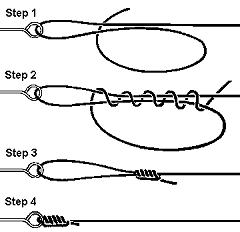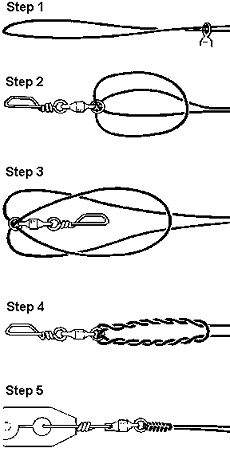|
Fishing Knots
|
 |
| Simple Loop Knot Easily attached to swivel or a hook, the loop knot is a simple knot of moderate strength. |
 |
| Half Blood Knot This is the Half Blood Knot or half of the Barrel Knot. CAUTION! THIS KNOT WILL SLIP. If you must use it, then you have two choices: a) Stop the end of the line with a simple Overhand Knot (see below), and draw it against the turns of the knot. b) or make the Half Blood Knot into a Clinch Knot (see further below). |
 |
| Half Blood Knot ...with an overhand added for insurance |
 |
| Clinch Knot feed the line through the eye of the hook, or swivel. Double back and make five turns around the line. Now slip the end of the line through the first loop above the eye, and then through the large loop. Draw the knot into shape. Slide the coils down tight against the eye. |
 |
| 3x Special Put 10 inches of line through the eye of the hook. Make a circle about 2 inches in diamiter. Put the end through again, making a second circle. Repeat this circle a third time. Holding the three circles of line against each other, wrap the end three times around the circles. Hold the hook firmly with pliers. Holding pressure on the hook, pull on both ends of the line to tighten. |
 |
| Palomar Knot Double about 12 inches of line, and feed it through the eye. Tie a simple Overhand Knot in the doubled line, letting the hook hang loose. Pull the end of the loop down, sliding it completely over the hook. Pull both ends of the line to shape up the knot. |
 |
| Hangmans Knot Thread 8 inches of line through the eye. Bring the end back on itself, passing it under the doubled part. Make five loops over the doubled part. The knot is then worked into shape. Slide the knot down the line, against the eye of the hook or swivel. The "standard" Hangman's Knot holds only five turns when tied in monofilament nylon. If tied in rope, and used for its stated purpose, it takes eight turns. |
 |
| Scaffold Knot Thread an 8 inch loop of line through the eye. Pinch the upper part between thumb and forefinger, making a loop. Make two more loops over the double part, holding them between thumb and forefinger too. Pass the end through the two loops just made as well as the first loop made in step 2. The knot can now be drawn into shape, and moved down against the eye of the hook or swivel. |
 |
| Snelling a Hook Thread the end of the line or leader through the eye twice, leaving a loop hanging below the hook. Hold both lines along the shank of the hook. Use the loop to wind tight coils around the shank and both lines, from the eye upwards. Use from 5 to 10 turns. Use the fingers to hold these tight coils in place. Pull the line (extending from the eye) until the whole loop has passed under these tight coils. After coils are tightened, use pliers to pull up the end of the line. |
 |
| Blood Knot Place the ends of the two lines against each other, overlapping about 10 inches. Take 5 turns around one line with the end of the other, and bring the end back where it's held between the two lines. Repeat by taking 5 turns around the other line, bringing the end back between the two lines. These two ends should then project in opposite directions. Manipulate the knot up into loops, taking care that the two ends do not slip out of position. Draw the knot up tightly. |
 |
| Line to Line using a Hangmans Knot Knot This is a knot used for attaching the line to the spool of the reel. Overlap the two lines for about 8 inches. Using one end, form a circle that overlies both lines. Twist the end six times around the two lines. Pull the end tight to draw the knot up into shape. Repeat the process using the end of the other line. Pull both lines to slide the two knots together. |
 |
| Surgeons Knot Lay the two lines against each other, overlapping about 10 inches. Working the two lines as one, tie an Overhand Knot. It will be necessary to pull one line (say the leader) completely through this loop. Pull the leader through this loop again. Pass the other end through the loop. The formed knot can now be worked into shape. |
 |
| Spider Hitch Form a loop of the desired length. Twist a section into a small loop. This is the only tricky part - hold this loop with thumb and forefinger, the thumb extending above the finger, and with the loop standing up beyond the tip of the thumb. Wind the doubled line around the thumb and the loop 5 times. Send the rest of the long loop through the small loop, and pull gently to unwind the turns off the thumb. The knot is now formed and worked into tight coils. |
 |
| Off Shore Swivel Knot This is a special knot used for attaching a swivel to a double line. Put the end of the double line through the eye of the swivel. Rotate the end half a turn, putting a single twist between the end of the loop and the swivel eye. Pass the loop with the twist over the swivel. Hold the end of the loop, together with the double, with one hand, and allow the swivel to slide to the end of the double loops that have formed. Continue holding the loop and the lines with the right hand. Use the left hand to rotate the swivel through both loops 6 times or more. Keep pressure on both parts of the double line. Release the loop. Pull on the swivel and loops of line will start to form. Holding the swivel with pliers, or (better still) attaching it with a short length of line to the rigging, push the loop down towards the eye while keeping pressure on the double line. |
 |
| Surgeons End Loop Loops are made for the purpose of attaching leaders or other terminal tackle. They have the advantage that they can be tied quickly and in the dark. The Surgeon's End Loop is an easy way to go. Take the end of the line and double it to form a loop of the required size. Tie an Overhand Knot at the desired point, leaving the loop open. Bring the doubled line through the loop again. Hold the line and the end part together, and pull the loop to form a knot. |
 |
| Blood Blight Knot Another end loop can be tied quickly and easily using the Blood Bight Knot. Double the line back to make a loop of the size desired. Bring the end of the loop twice over the doubled part. Now pass the end of the loop through the first loop formed in the doubled part. Draw the knot up into shape, keeping pressure on both lines. This knot can be used when fishing with minnows. Use several hooks with a sinker attached at the bottom. |
 |
| Dropper Loop A better choice for forming a loop, or loops, in the line above a sinker is to use the old Dropper Loop. This draws into a knot that stands out at right angles to the line. If desired, the loops can be made long enough to have a hook attached to them. Form a loop in the line. Take hold of one side of the loop, and make 6 or more turns around the line itself. This is the tricky part - keep open the point where the turns, or twists, are being made. Hold the other side of the loop, and pull it through the center opening. use a finger in this loop so that it is not lost. Hold this loop between the teeth. Pull gently on both ends of the line, making the turns bind down on either side of the loop. Draw up the knot by pulling the lines as tightly as possible. The turns will make the loop stand at right angles to the line. |
 |
| Tucked Sheet Bend Usually employed by the fly fisherman, the Tucked Sheet Bend is commonly used for joining the backing line to the tapered line. It is not an especially compact knot, but has a very strong attachment which cannot be said for the more aesthetically pleasing Perfection Loop. Make a Blood Bight (see above) at the end of the backing line. Take the end of the tapered line. Pass it through the Blood Bight and make a simple Sheet Bend. Now thread the end of the tapered line back through the closed loop of the Sheet Bend. Hold both ends of the tapered line to tighten and pull into shape. |
 |
| Float/Bobber Stop The bobber fisherman uses a running float for casting and general handiness, and stops the float from running up the line by using the Float or Bobber Stop. It has the advantage that the stops moves readily over the rod guides, but grips the monofilament nylon so tightly that it will not slide over the line. It should be made with about 15 inches of nylon, usually the same diameter as the line itself. Take 2 turns (3 if necessary) around the main line at the chosen point. Bring both ends around to form a Surgeon's Knot (see above). Tighten into shape bringing the coils close together. |
 |
| Turtle Knot The turtle knot should never be used for light lines, and there are better knots for use with heavy ones. Thread the line through the eye of the hook. Make a simple loop. Carry the end of the line on to make a Simple Overhand Knot upon the loop. Slide the loop over the hook and pull into shape. |
 |
| Double Turtle Knot Thread the line through the eye of the hook or swivel. Make two simple loops, and continue the line on to make a Simple Overhand Knot around both loops. Slide both of these loops over the hook or swivel. Pull on both parts of the line to work the knot into shape against the eye of the hook or swivel. |